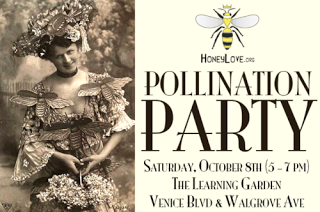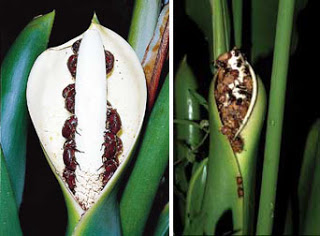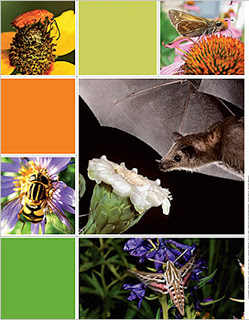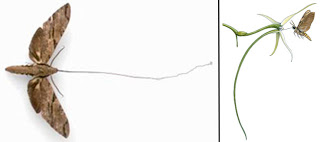Biology
Imagine the best party of the year ? it?s cold outside, but hot inside. The food is great, all your friends are there, everyone is receptive to flirtations by the opposite sex, it lasts for two nights in a row where it is, and then picks up in a new location again and again. Where is it and how do I get invited?
As the party winds down in this first P. selloum, the temperature is reduced and the spathe starts to close down on the spadix, forcing the beetles out ? it?s closing time, you don?t have to go home, but you can?t stay here (lyrics by Third Eye Blind). As the beetles leave the flower two things happen, first they pass the viscidium, which coats the beetles with a sticky substance, and then they pass by the pollinia, which covers them with pollen grains.
This is one type of pollination party, but not the only one. Most plants invite a variety of different pollinators, or a plant might self-pollinate. In some orchids of colder regions where pollinators are particularly rare, self-pollination can be a last resort. If the flower is not visited by any pollinator, the caudicle (the stalk on which the pollen resides) will shrivel up in a particular shape, dropping the pollen directly on the stigma (containing the eggs).
Another advantage is seen after the pollen is gathered on the pollinator. In order for a pollination to be successful, the pollen must be delivered to the female organs of a plant of the same species. If a pollinator species has developed a relationship with a certain plant (attracted by a specific odor or color, etc.) then the chances are higher that it will visit another plant of the same species after gathering pollen. This increases the chances of cross-pollination.
P. selloum is an interesting exception to the rule of multiple pollinators, but there are other examples. For instance, orchids are famous for finicky pollination. There are >25,000 species of orchids, the largest group of plants (in contrast, all birds represent only ~10,000 species), and single pollinators are responsible for the propagation of thousands of them. In South America and South Africa, the number of single pollinator species is quite high, including many orchid species. (Why? I have no idea.)
- Mutualism
All flowers have mutualistic relationship with bees. In order to make their honey, bees travel from flower to flower collecting nectar. On the other hand, when the bee goes from flower to flower it brings pollen with her, resulting in pollination. The...
- Pollen: Evolution
In this picture is pollen that got stuck to the ground because of juice or water. Pollen has been flying around because plants and flowers are blooming and they are ready to fertilize. Pollen is like a tiny grain inside id a seed plant which usually...
- Comparison Between Self Pollination And Cross Pollination
Self pollination and Cross pollination: Major differences Self pollination Cross pollination 1. Pollen grains are transferred to stigma of same or genetically similar flower. Pollen grains are...
- Sunrise, Sunset ? Life In The Twilight
Biology concepts ? activity patterns, crepuscular, co-evolution, active pollination Nocturnal and diurnal activity patterns are like vanilla and chocolate cupcakes. But what if you like rose hip or green tea flavors ? are there cupcakes out there for...
- Boys Will Be Boys? And Then Girls
Biology concepts ? botany, monoecious, dichogamy, imperfect and perfect flowers, self-pollination, cross-pollination, self-incompatibility, heterostyly This clip shows the mating of hermaphroditic leopard slugs. Each may provide male gametes for...
Biology
The Perils of Plant Monogamy
Biology concepts ? pollination, single pollinator, co-evolution, co-divergence
 |
What?s bugging her, it?s supposed to be a party! |
Last week we learned that the Philodendron selloum flower becomes endothermic for a 2 day period each year in order to facilitate its pollination. In this state, it attracts a single species of beetle, which parties down inside the flower and then takes the pollen to the next party - sort of BYOP.
The heating of the P. selloum spadix evaporates and spreads a pheromone that attracts male Cyclocephala beetles. Pollination by beetles (cantharophily) is not one of the most common mechanisms for the spread of pollen to ovules; pollination by bees (melittophily), butterflies (psychophily), or even the wind (anemophily) is more common. In most cases of cantharophily, the flowers are big, white, strong-smelling, and the male flowers are usually eaten but the ovaries are protected. This is exactly the scenario in P. selloum.
When the male beetles enter the flower, the angle of the spadix makes the male flowers available to be eaten, while the covering of the spathe discourages the beetles from leaving the pit. The nectar, pheromone, and flowers help draw the beetles in, but it is really the atmosphere and the company that keep them there.
Female beetles are drawn to the warm temperatures as well, as this affords the beetles the ability to feed and mate through the night, when the ambient temperature outside the flower would require them to slow down their activity (being ectotherms).
 |
The Cyclocephala beetles, but there are other examples. Orchids are famous for finicky polli beetles follow the pheromone back to the flower, and after partying, the flower closes down and kicks them out. |
The next night, a new P. selloum is ready to open its doors for the party. When the previous night?s revelers show up with their coating of pollen, they head directly to the nectar bar at the bottom of the pit, right where the female flowers are located. While getting their first drink of the night, they deposit the pollen on female flowers that reside there and pollinate the plant. The beetles do the work, but their rewards (increased mating time, increased food) are as important to them as the pollen is to P. selloum.
 |
Pollinators can various animals.Non-animal pollinators work in some cases too, such as wind and water. |
Most plants invite pollinators of different species. One bee may be a particularly effective pollinator of a particular plant, but that plant is probably also visited by a fly, a butterfly, a bird, a beetle, etc. Few plants have a single pollinator, but P. selloum is one exception. While Cyclocephala beetle may pollinate other plants as well, it is the only species that pollinates P. selloum.
Single pollinators provide advantages to the plant. The need to attract only one species reduces the energy a plant must expend to attract multiple pollinators. Some pollinators are attracted to color, some to different scents, some to different UV patterns, some to different nectars. To draw different pollinators the plant will have to have many attractants, and this costs energy.
 |
The more pollinators a flower depends on, the more energy the plant must spend on attractants. For instance, some flowers use color and UV patterns, as on the left. Some flowers use nectar and visible light patterns, as with the pitcher plant. The red flower is rafflesia, the largest flower in the world. It smells like rotting flesh to attract flies. Some flowers use mimicry, like the bee orchid on the right, it looks like a female bee and attracts males that will try to mate with it. |
The dependence of a plant on a specific pollinator amplifies the plant?s vulnerability if there is a decrease in the pollinator numbers. It has no second option for pollination. This is one reason why cross-pollination is preferred to self-pollination. Evolution does not anticipate the future; it proceeds as if the pollinators are present in good numbers. The plant needs the greatest diversity of gene mutations and rearrangements in order to adapt to unanticipated changes in pollinator number, behavior, or preference. This diversity is provided by cross-pollination with another plant, not by reiteration of existing gene patterns by pollination with the plant?s own genome.
The disadvantage of employing a single pollinator is becoming more obvious. Recent years have seen large decreases in wild pollinator populations. Honeybees have experienced colony collapse disorder, and 2011 figures indicate that 10% of American bumblebee species are near extinction. More than 40 species of pollinating insects in the US are endangered, and even more shocking, 1200 vertebrate species of pollinators are termed ?at risk.? If this many pollinator species are in decline, even plants pollinated by multiple species might feel the pinch. Can you imagine how many plants that rely on a single species of pollinator might be in danger of extinction?
 |
Many orchids use a single pollinator. Orchids are the most diverse flower group, as show by the Dracula orchid, the spectacle orchid, and the small tongue orchid, left to right. |
The specific interactions between the single pollinator and the plant it pollinates are often a result of co-evolution. In technical terms, this means describes the reciprocal natural selection and evolutionary change that occurs between two species by exertion of selective pressure on each other. The two species could be trying to outfox one another, like a parasite and its host, or could be working together, like the pollinator and pollinated.
As the two interacting species interact, they may evolve so that they rely solely on each other for that particular interaction. This could also lead to each species diverging from its closest relatives. This particular type of co-evolution is called co-divergence.
Co-divergent speciation can be seen in the host parasite relationship between the malaria parasite, Plasmodium falciparum, and humans. When humans and chimps diverged (about 4-7 million years ago), some P. falciparum evolved to infect only chimps, while others followed human evolution and became specific for humans.
 |
The Darwin hawk moth wasn?t known when the star orchid was first described. Charles Darwin just predicted it must exist. Predicting the existence of a moth with 35 cm tongue didn?t win Darwin many fans, but he was right. |
In similar fashion, there are numerous plants that have co-evolved with a pollinator. The Angraecum sesquipedale orchid (star orchid) is a classic example. Charles Darwin was sent several examples of this flower and described them in an 1862 publication. Darwin noted that the nectar of this flower was located deep within a hollow spur. To reach the nectar, a pollinator would bump into the pollen and it would stick.
However, the tube was so narrow, that no known insect could have been considered a pollinator of this plant. Darwin predicted that an insect with a 30-35 cm proboscis (tongue-like appendage) would be found pollinating A. sesquipedale. He was ridiculed for such a bold proposition, but 40 years later, just such an insect was discovered, the Xanthopan morganii praedicta moth (named for Darwin?s prediction).
Nature is full of exceptions to the rule of multiple pollinators, including snapdragons that need a bee of specific weight to trip the opening mechanism of the flower. Several orchids that use the same single pollinator place the pollen on different parts of the pollinator?s body, so that female flowers of the same species will come into contact with the correct pollen. These are still exceptions, as the vast majority of plants use multiple pollinators ? they just aren?t as interesting.
We have seen a plant that can become endothermic in order to pollinate. Next time we will look at a mammal that has gone the other direction, but for the same reason - survival.
For more information, classroom activities and laboratories on P. selloum, pollinators and co-evolution, see:
P. selloum ?
http://www.floridata.com/ref/p/phil_bip.cfm
http://faculty.ucc.edu/biology-ombrello/pow/Philodendron.htm
http://www.exoticrainforest.com/Philodendron%20bipinnatifidum%20pc.html
http://www.pburch.net/plants/C3397731/E20060506081651/
pollinators ?
http://www.pbs.org/wgbh/nova/nature/pollination-game.html
http://pollinatorlive.pwnet.org/teacher/lessons.php
http://www.smithsonianeducation.org/educators/lesson_plans/partners_in_pollination/lesson1_main.html
http://www.nebraskawildlife.org/ww08-PollinatorCurriculum.htm
www.mbgnet.net/bioplants/downloads/pollination.pdf
www.nybg.org/files/pollination.pdf
www.ableweb.org/volumes/vol-22/12-puterbaugh.pdf
www.ppdl.purdue.edu/ppdl/expert/Pollinate_Tomato_Pumpkin.html
www.infocusmagazine.org/6.3/env_pollinators.htm
www.pollinator.org/Resources/facts.Gardeners.pdf
co-evolution ?
www.pbs.org/americanfieldguide/teachers/insects/insects.pdf
http://www.teachersdomain.org/resource/tdc02.sci.life.evo.lp_speciation/
www.stanford.edu/group/stanfordbirds/text/essays/Coevolution.html
http://www.ucl.ac.uk/~ucbhdjm/courses/b242/Coevol/Coevol.html
http://evolution.berkeley.edu/evosite/evo101/IIIFCoevolution.shtml
http://bioweb.cs.earlham.edu/9-12/evolution/HTML/converge.html
http://www.universityofcalifornia.edu/news/article/4463
http://www.teachersdomain.org/resource/tdc02.sci.life.evo.lp_speciation/
- Mutualism
All flowers have mutualistic relationship with bees. In order to make their honey, bees travel from flower to flower collecting nectar. On the other hand, when the bee goes from flower to flower it brings pollen with her, resulting in pollination. The...
- Pollen: Evolution
In this picture is pollen that got stuck to the ground because of juice or water. Pollen has been flying around because plants and flowers are blooming and they are ready to fertilize. Pollen is like a tiny grain inside id a seed plant which usually...
- Comparison Between Self Pollination And Cross Pollination
Self pollination and Cross pollination: Major differences Self pollination Cross pollination 1. Pollen grains are transferred to stigma of same or genetically similar flower. Pollen grains are...
- Sunrise, Sunset ? Life In The Twilight
Biology concepts ? activity patterns, crepuscular, co-evolution, active pollination Nocturnal and diurnal activity patterns are like vanilla and chocolate cupcakes. But what if you like rose hip or green tea flavors ? are there cupcakes out there for...
- Boys Will Be Boys? And Then Girls
Biology concepts ? botany, monoecious, dichogamy, imperfect and perfect flowers, self-pollination, cross-pollination, self-incompatibility, heterostyly This clip shows the mating of hermaphroditic leopard slugs. Each may provide male gametes for...
